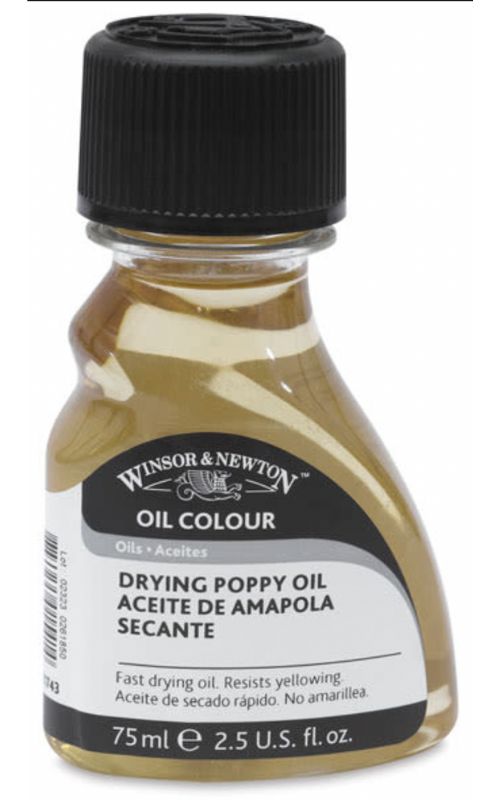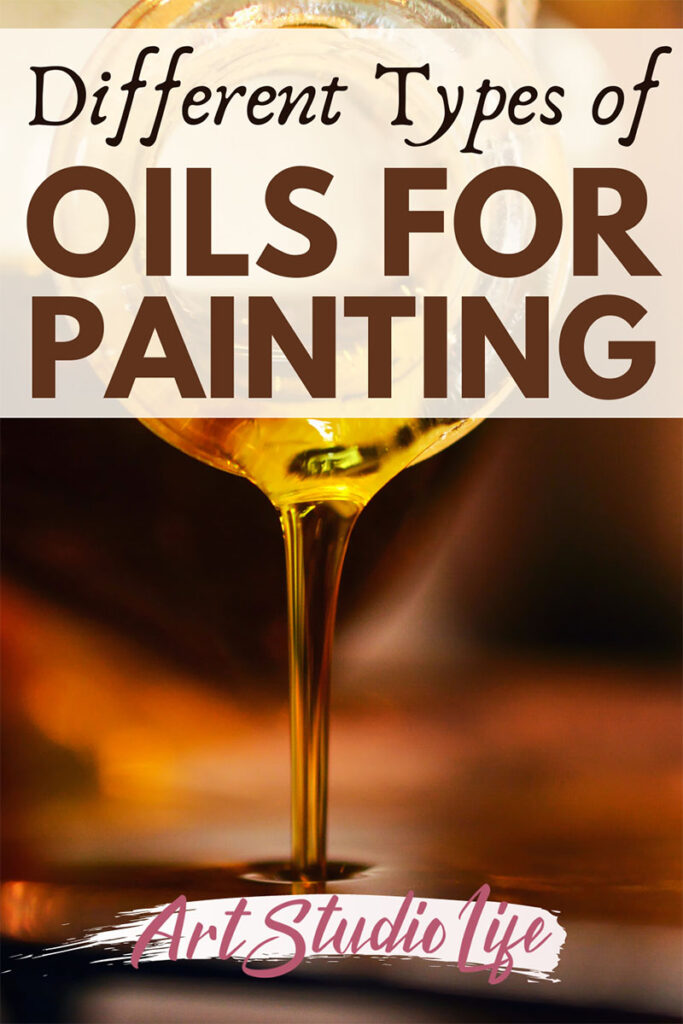What are the different types of oils for painting? If you’re an oil painter, you know that oils are essential to the medium. Your oil paints already have oil in them, but using additional oil is sometimes necessary as well. Whenever your paint is too thick or dry, oils help too thin it making it easier to use.
But what oils should you get? That is what we will tackle in this article.

Types of oils for painting
There are different categories of oil types that every painter should know about:
- Drying oils: these are the most common type of oil used in painting. They include linseed oil, poppy seed oil, and walnut oil. Drying oils form a tough, flexible film over time as they dry.
- Semidrying oils: These oils take a little longer to dry than drying oils, but offer more flexibility. They include safflower oil, sunflower oil, and soybean oil.
- Non-drying oils: Some examples of non-drying oils are baby oil, olive oil, almond oil among quite a few others. Non-drying oils will never harden or dry like other types of paint do. You do not want to ever use such oils for painting as then your painting will never dry.
So, the main varieties of oils best suited for painters are drying oils and semidrying oils. These oils do not dry via evaporation, but absorb oxygen to become solid in form. Once dried, they cannot return to liquid form.
These oils serve four purposes for your painting:
- They act like a glue binding the pigment to the ground.
- Oils help to bring out greater depth in the color
- Help protect the pigment for years to come by binding them in an enveloping film.
- Help to thin your paint when your paint is too thick or dry
Linseed oil for painters
Linseed oil is one of the most popular oils for painting. It is derived from the seeds of the flax plant and has been used for centuries. Though linseed oil for painting is essentially the same as the flaxseed oil you come across at a grocery store, take note that it is not edible! The extraction method used to make artist’s linseed oil uses petroleum – not something you would want to consume.

Linseed oil dries slowly, which gives artists more time to work with it. It also has a high gloss finish when dry, making it ideal for creating vibrant colors.
It’s also very versatile and can be thinned with solvents such as turpentine, or used as a varnish. It can also be mixed with other oils to create different effects.
There are a few different types of linseed oil available at the art store. We will cover each of them so that you will know which is best for you.
Cold Pressed Linseed Oil
Cold pressed linseed oil has been used in oil painting for centuries, and for good reason. This type of oil is pressed from flax seeds that have been cold-pressed, meaning they haven’t been heated before being turned into oil. This results in a purer product that still retains all of the benefits that linseed oil has to offer.

Some of those benefits includes its ability to improve the flow of paint and increase the luminosity of colors. It also dries faster than other oils, which can be a major advantage for artists who want to work quickly. And because it’s less likely to yellow over time, cold pressed linseed oil can help your paintings maintain their original beauty for longer.
Cold pressed linseed oil for painting does contain more impurities than other types of linseed oil as can be seen by its color. However, these impurities don’t affect the quality of the oil.
Refined Linseed Oil
Hot pressed linseed oil requires further refining which typically means that it is mixed with sulfuric acid and water which removes its impurities and improves its color. The result is a more yellow oil that dries to a harder film. It is excellent for underpainting and glazing. You can also add it to your paint to make it more transparent and increase gloss.

The downside of refined linseed oil is that it increases yellowing over time, so it may not be the best choice for paintings that you want to keep for a long time. You will find refined linseed oil in a variety of different colors from a golden light amber to a light straw color. When given the choice I recommend to get the golden/ amber colored linseed oil over the lighter bleached version. This is because the lighter colored linseed oil has a tendency to become darker in color as it ages.
Slower drying oils for painters
The following oils can also be used for painting. They each have their advantages and disadvantages next to linseed oil. One thing they all have in common is that they tend to dry much slower when compared to linseed oil.
Poppy Oil

Poppy oil is naturally colorless to straw colored with none of the characteristic golden or amber color of linseed oil. So, dried poppy oil has less tendency than linseed oil to turn yellowish over time. However, it still will turn yellow to some extent.
Also, poppy oil dries more slowly than linseed oil and is a good choice for those who wish to work wet in wet (or alla Prima) longer.

However, a serious defect of poppy oil is that its paint films are more likely to crack over time. Thus it is considered to be an inferior oil for painting when compared to linseed oil.
The best use for poppy oil is for alla prima painting where simple direct painting methods are used. It is best not to use poppy seed oil for complex multiple layered paintings.
Walnut Oil
Walnut oil has been used to make paint for a long time – longer than linseed oil. Like poppy oil, walnut oil yellows less than linseed oil. When dry, the film of walnut oil is stronger than poppy oil. However, linseed oil is still stronger than both. Walnut oil has a silky texture to it with a similar drying time to poppy oil.

However, the big downside to walnut oil is that it must be used when fresh. It will grow rancid in storage and eventually develop a strong odor. This makes it less than ideal oil for painting.
Safflower Oil

Safflower oil for painting is obtained from the seeds of carthamus tinctorius and c. oxyacantha, plants that are mainly found in India, as well as East Africa, Egypt and Turkey. It is a slower drying oil when compared to linseed oil. And similar to poppy seed oil and walnut oil it is less likely to yellow over time when compared to linseed oil.
Using safflower oil can also be a decent replacement for linseed oil. However, it does not have much resistance to cracking and therefore linseed oil is still considered a superior oil for painting.
Sunflower Oil

Sunflower oil has similar properties to poppy oil and safflower oil and is sometimes used as a substitute for linseed oil.
This oil is less yellowing with a slower drying time compared to linseed oil. However, since sunflower oil is not a common oil for painting it is much more difficult to find.
Best oils for YOUR painting

Linseed oil historically superior
There are quite a few different oils that can be used in oil painting. Most oil paints are made with linseed oil, though there are a few brands that use walnut oil – most notably graham paints. However, no matter what kind of oils are used in your paints – you can use any drying or semidrying oil as a paint thinner with it.
However linseed oil is historically considered to be a superior oil for painting and is still considered so today.
The highest quality paints use linseed oil because it is the most archival of all the oils and less likely to crack with time.
Oil for alla prima painting
If you would like to do a lot of wet in wet alla prima painting then poppy oil may be good to make use of and use as a paint thinner. Just make sure to only paint a single layer with it as otherwise the paint will not dry as it is meant to.
Traditional oil paints and water soluble oils
All of the oils mentioned in this article can be used with traditional oil paints as well as water soluble oils! If you do use water soluble oil paints then be sure to keep the amount of oil used to a minimum. Otherwise you will lose the ability to mix water with the paint
What oils are your favorite to use? Let me know in the comment section below!







10 thoughts on “Types of Oils for Painting and the Best Oils for You”
My favorite oil to paint with is walnut oil. I seem to be sensitive to the smell of linseed oil but have no problem with the walnut oil. Hence I use mainly M. Graham oils which are made with walnut oil. Is there a type of linseed oil that doesn’t have the odor?
Your website is a wealth of information! Thank you.
Hi Mearced, I love M. Graham paints! They were the first oil paints I used, and still keep them in my stash of paint. That is great that you found that walnut oil is better for you to use. It also dries slower than linseed oil which can help to paint ‘wet in wet’ longer.
Unfortunately I don’t know of a linseed oil that doesn’t have the characteristic smell. However, the good thing to know is that it does not release harmful fumes like solvents. Am so glad that my website is a rich source of information for you, thank you for sharing!
I am very satisfied with Linseed Oil you pictured.
I had an extra eye dropper I use to remind myself to only use a small amount.
I see there is oil in the tubes of the pigment of my water soluble oil paints from the same company.
I like to paint in thin layers.
Thank you, Elisabeth for such a detailed article on this subject.
Hi Patricia, Good to hear from you! That is great that you use an eye dropper with it. It is easy to accidentally use too much – and then the paint loses all its body as it has far too much oil mixed with it!
Linseed oil is definitely your friend as it helps with your layered painting method. Love the way you work very much! 🙂
You are so welcome! Thank you for taking part in reading the information.
Thank you for share.
I have curiosity about stand oil, what do you think about it?
Thanks again, and best regards!
Hi Joe, You are very welcome! Stand oil can be really great. It has rather unique characteristics as it is thicker in consistency than other oils (about the consistency of honey). It can be thinned though by mixing it with some turpenoid. It is not a good oil to grind into pigments/ to make paints with. However it is great to use as a varnish and to use as a thinner for your paints. One great advantage of it is that it yellows much less over time than raw linseed oil does. It also has a tendency to dry to a very smooth enamel like finish.
Elizabeth, Thank you for all the information you give us on your site. You are very Giving!! I always look for your sites that come up on Pintrest.
Thank you again.
Mary Lou McCarthy
Hi Mary Lou, You are so very welcome! I am very glad that it is helpful! Happy to hear that you keep an eye out for Art Studio Life tutorials that come up on Pinterest 🙂
I apologize that my question is not concerning oils at this time. I am about to do a watercolor painting and my question is: How should a watercolor painting be preserved?
* Just mount in a frame with a glass cover or seal with a spray or another means?
* Also; can I use a large canvas board for the painting. (I have one left over from earlier years).
I am 81 and no art experience other than a couple of oil paintings 50 years ago and some recent (color and graphite) pencil drawings.
I’m thinking about large white flowers with an aqua hued background painting for over the fireplace.
That is quite alright! I work with all different aspects of painting here 🙂 One good way to preserve a watercolor painting is to first use high quality watercolor paints. Cheap watercolors are not made to be lightfast and so will fade (rather) quickly to light exposure. So, first it is good to make sure you are using good quality paints that won’t fade with time. Also, mount the watercolor painting on acid free mat (this keeps it from discoloring with time). Keep your watercolors out of any direct sunlight – light is a major reason for any fading that happens. Framing your watercolor painting with museum glass will filter out roughly 98% of ultraviolet light and so can be a great help to conserve your painting. Spraying varnish on a watercolor painting for further preservation is a permanent non-reversible addition to the piece. It will change the appearance of the painting – so I personally would not recommend it.
Is this canvas board you have a mounted canvas glued down to a board? This will not be an ideal surface for watercolor painting but you could certainly use it for it. However, I would recommend using acrylics or oil paints with it. Cotton watercolor paper is the best to use with watercolors.
Thanks for your questions – I hope that helps!